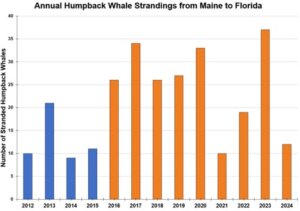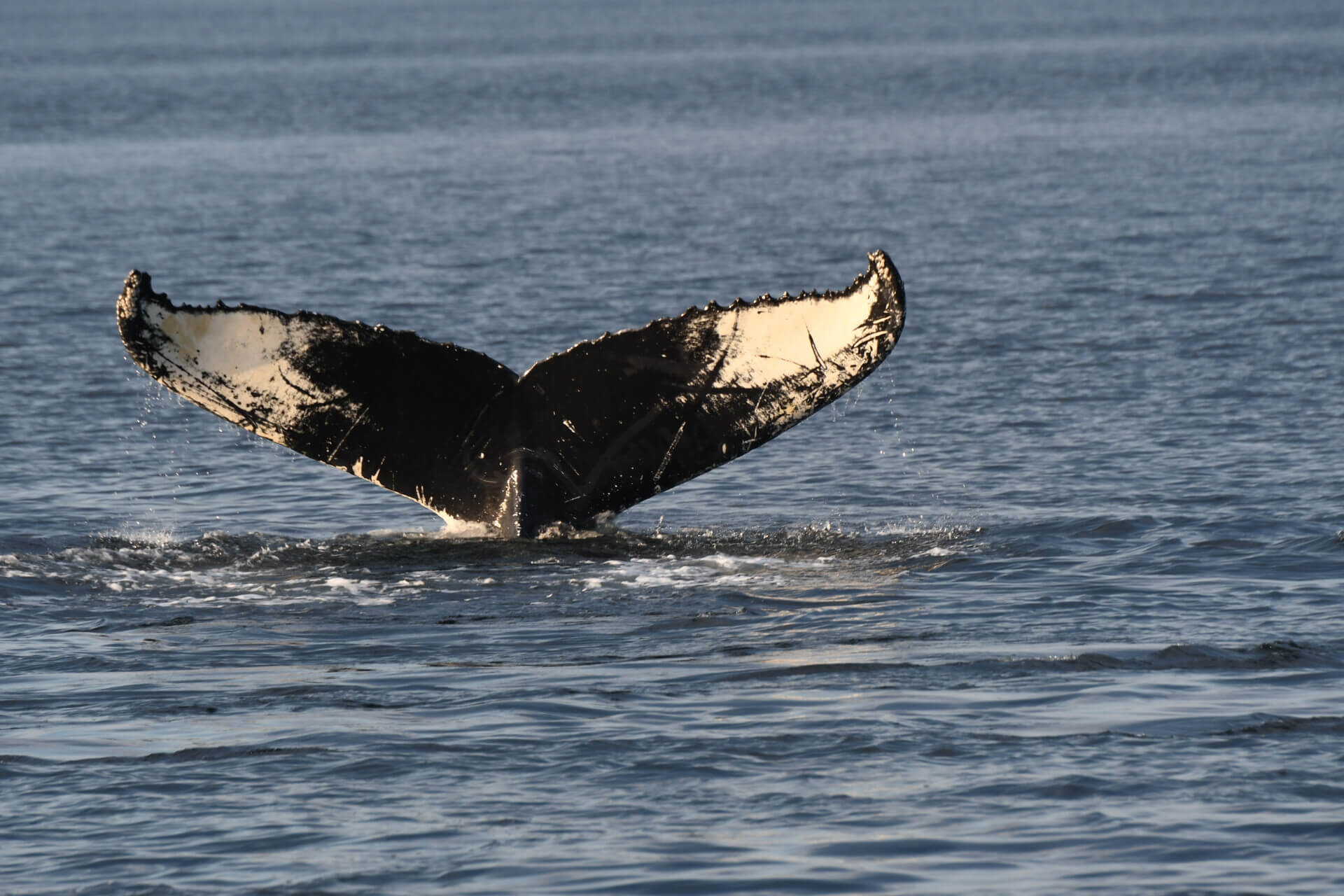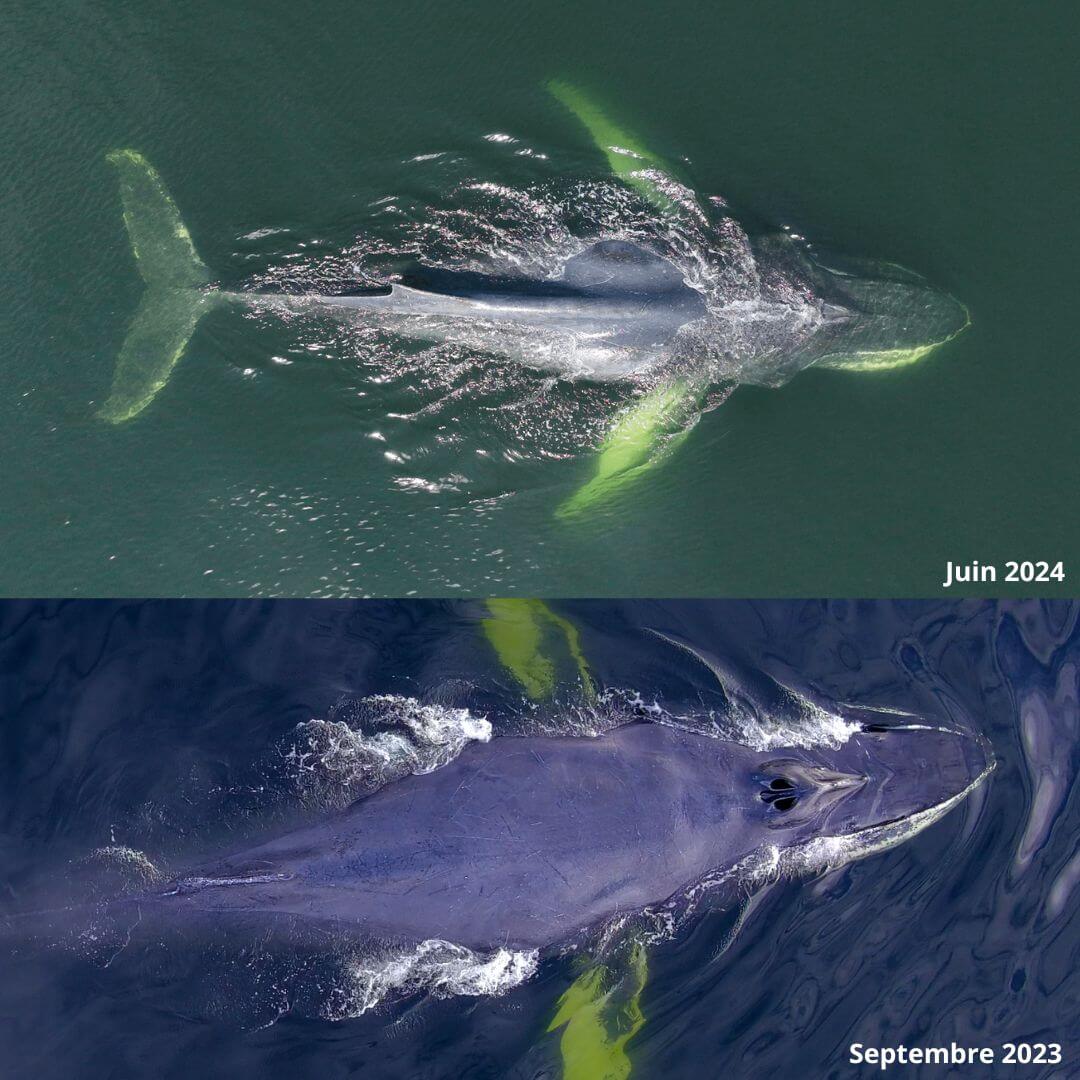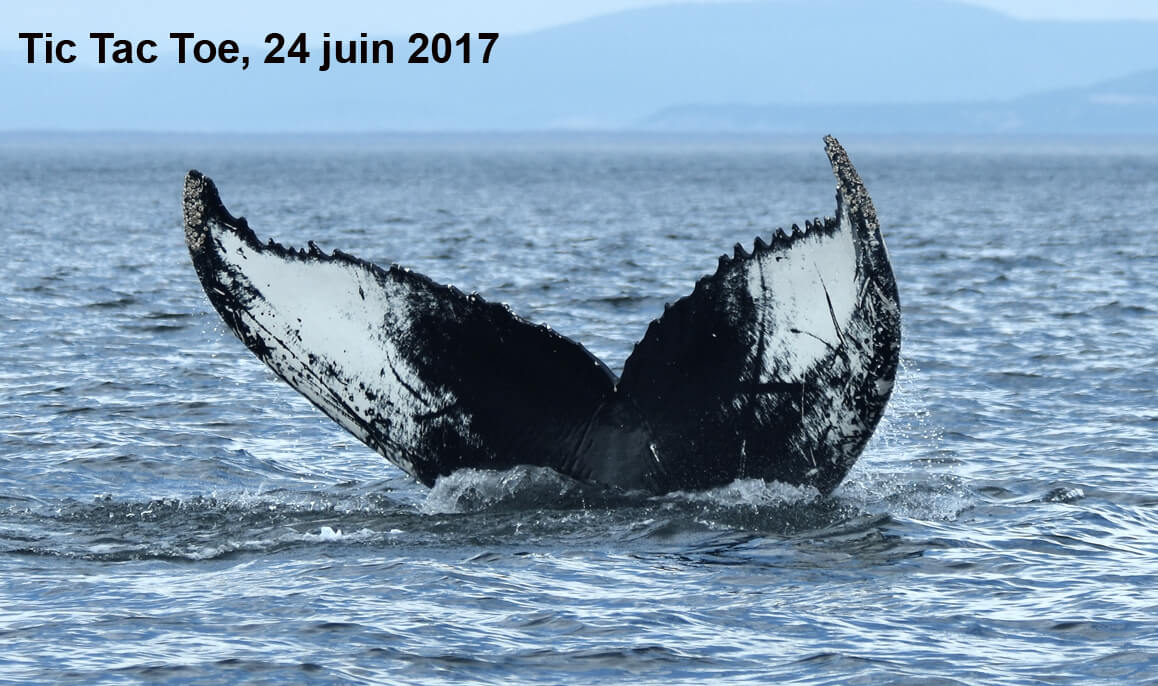The humpback whale Tic Tac Toe has been back in the Marine Park since May 29. Images transmitted to the Quebec Marine Mammal Emergency Response Network (QMMERN) show a severely emaciated animal. This page was created to monitor Tic Tac Toe’s situation and will be updated with each new development to provide information in the timeliest manner possible.
In order to give her the best chances of survival, we would like to remind all visitors to the Saguenay-St. Lawrence Marine Park to keep their distance from Tic Tac Toe and to not include her in their observation activities.
If you think you see her, even if you’re not sure, keep your distance and contact QMMERN immediately at 1-877-722-5346. Do not approach to take photos or videos.
What’s happening to Tic Tac Toe?
When they return to their spring feeding grounds, large rorquals are often thin. However, Tic Tac Toe’s physical condition is unusual. Consultations with scientists who work with large populations of humpback whales confirm that Tic Tac Toe’s situation is extreme. At this level of emaciation, veterinarians believe her chances of survival are low.
Drone flights carried out on June 1 and 5 failed to detect any signs of collision or entanglement that might explain Tic Tac Toe’s condition. At the present time, it is not known how Tic Tac Toe came to find herself in this critical state. It is also unknown whether or not she is able to feed on her own.
However, we do know that animals in a comparable state can survive for several weeks or even months. Very few cases of recovery have been observed, however. These situations are usually irreversible. Tic Tac Toe’s fate will depend on her ability to feed on her own. The presence of good numbers of large rorquals in the Marine Park in recent weeks suggests that food is abundant.
Brief recap of Tic Tac Toe’s bio
Tic Tac Toe was first observed in the Marine Park in 1999. Two years prior to that, she had been observed in the gulf accompanied by her mother Quartz (H150) during her very first migration north. Tic Tac Toe is 27 years old.
Before Tic Tac Toe appeared in the Marine Park, just one other humpback had ever made brief incursions into the estuary: Siam (H007). Since then, the numbers of humpbacks have increased considerably and Tic Tac Toe has a lot to do with this. She has also been observed with a total of 6 calves, including her first one, Aramis, who had an offspring of her own in 2020. Tic Tac Toe is therefore a grandmother.
Timeline of events
>>6 June 2024
For the moment, we don’t know what led Tic Tac Toe to this state, but drone images taken in September 2023 show that she was already emaciated compared with the other humpback whales present in the estuary. Her condition has deteriorated in recent months. It is not known whether Tic Tac Toe is able to feed herself. However, it is known that animals in a similar condition can survive for several weeks, even months. Few cases of recovery have been observed, however. These situations are usually irreversible.
>> June 5, 2024
The presence of Tic Tac Toe is reported to the RQUMM team. At around 12:30, the GREMM monitoring team leaves Tadoussac with the Park Canada conservation team to carry out a second Tic Tac Toe survey (drone flight, ventilation monitoring) off Cap Granite. The drone images did not reveal any signs of collision or entanglement. The veterinarians and experts consulted consider his condition to be critical.
Tic Tac Toe’s fate will depend on his ability to feed. The presence of a good number of great whales in the marine park over the past few weeks suggests that food is available. It’s by not disturbing Tic Tac Toe that we’ll be able to encourage his recovery.
As of June 5, this will be Tic Tac Toe’s last confirmed sighting.
>>June 2, 2024
The veterinarians and experts consulted judge its condition to be critical. An intervention plan is set in motion to minimize disturbance to the animal and monitor its condition on a weekly basis.
>>June 1, 2024
A vigilance notice is broadcast over the radio to the Saguenay-St. Lawrence Marine Park community, asking users of the area to stay away from Tic Tac Toe and not to include him in their observation activities. Around 11:00, Tic Tac Toe is observed off Pointe-Sauvage.
Around 12:00, a Park Canada boat leaves Tadoussac with members of the GREMM research team to follow up on the animal. The first drone images reveal the severity of its emaciation.
>> May 31, 2024
RQUMM receives a first report: Tic Tac Toe is moving slowly, and his movements seem labored. The RQUMM receives the first images, and veterinarians are quickly consulted to assess the whale’s condition.
>>May 29, 2024
Tic Tac Toe was reported sighted in the Saguenay-St. Lawrence Marine Park on the morning of May 29. Among the whales of the St. Lawrence, this female humpback whale is the star of the show. It’s probably one of the best-known whales in the St. Lawrence: it’s easily identifiable, it’s been swimming up the estuary almost every year since 1999, and it regularly shows its fluke. Tic Tac Toe owes its name to the large “X” visible on the right lobe of its tail. Its pronounced serration and black-and-white color pattern make it relatively easy to identify.
On first sighting, it is already noticeable that she is a little thin, but the severity of her condition is unknown.
Tic Tac Toe still in poor shape – Your questions
Excerpt from the PDB of August 22, 2025 | Volume 24 | Number 10
This question is coming up often this year! Tic Tac Toe usually arrives early in the season, but we still haven’t identified her this summer. The last confirmed sighting of her in the estuary was on June 5, 2024, at which time she was very emaciated. Assessments of her condition by veterinarians and humpback whale experts all pointed to the same conclusion: The odds of her surviving were low. Everything suggests she was unable to properly feed, and we should point out that very few recovery stories have been noted in similar situations.
H509, nicknamed Tic Tac Toe due to the large “X” visible on the right lobe of her caudal fin, is one of the Marine Park’s most famous whales. The combination of her distinctive features (which make her easy to identify), her fiery personality, and her annual visits to the St. Lawrence have left an indelible mark on the minds of those who frequent the region. GREMM’s large rorqual research team notes that while Tic Tac Toe’s chances of recovery are low, these animals are known for their incredible resilience. Without a documented stranding or a carcass at sea, we may never know what has actually happened to her!
Tic Tac Toe and her spout (foreground) with her 2017 calf H855 (breaching in background). While we might not see this star of the St. Lawrence ever again, she has left us with memories for years to come, with at least four calves that visit the Marine Park, including Aramis, who has even had a calf of her own!
As soon as the worrying state of Tic Tac Toe was reported, QMMERN immediately sent out an advisory by email and radio encouraging members of the Saguenay-St. Lawrence Marine Park community to keep their distance from the animal.
A monitoring plan was put in place to assess Tic Tac Toe’s condition. This entails taking drone images, tracking breathing sequences and taking photos of the individual. Two trips to the field have already been carried out to date. These monitoring sessions are carried out at a distance of 400 metres to avoid disturbing the animal. The ensuing data are valuable for assessing Tic Tac Toe’s state of health and better preparing response teams to intervene if necessary.
Through the weekly newsletter Portrait de baleines Express, QMMERN shares the latest news on Tic Tac Toe’s situation with the Marine Park community. In these bulletins, QMMERN also urges users in the sector to be extra cautious. The Whales Online team is joining forces with QMMERN to provide regular updates on the situation.
Should the animal become stranded or die at sea, every effort will be made to carry out an examination of the carcass called a necropsy. Determining the causes behind the worrying state of this particular humpback whale is essential to better understanding its species and the threats it faces.
By taking care not to disturb Tic Tac Toe, we can help her recover. In order to give her the best chances of survival, we would like to remind all visitors to the Saguenay-St. Lawrence Marine Park to keep their distance from Tic Tac Toe and to not include her in their observation activities.
If you think you see her, even if you’re not sure, keep your distance and contact QMMERN immediately at 1-877-722-5346. To follow the latest developments in the situation, do not hesitate to subscribe to the weekly Whales Online newsletter.
Learn more : Five Things You Can Do to Help Whales (Whales Online, 2023)
Tic Tic Tac Toe belongs to the North Atlantic population of humpback whales, which is estimated to number between 11,800 and 14,300 individuals. The species is believed to use six summer feeding grounds: the Gulf of Maine, Newfoundland and Labrador, the Gulf of St. Lawrence, western Greenland, southern Iceland, and the Barents Sea north of Scandinavia. In the gulf and estuary, several hundred individuals have been recorded over the years. The Mingan Island Cetacean Study (MICS) maintains a catalogue of over 700 individuals.
After being hunted to the brink of extinction, humpback whales now appear to be recovering, with a global population of around 80,000 individuals. Since 2003, the western North Atlantic population has been classified as “Not at Risk” by the Committee on the Status of Endangered Wildlife in Canada (COSEWIC). Humpback whales are no longer on Quebec’s list of species likely to be designated as threatened or vulnerable under the Act respecting threatened or vulnerable species. In the United States, on the other hand, the humpback is still classified as endangered.
The National Oceanic and Atmospheric Administration of the US Department of Commerce noted an unusual mortality event (UME) in the North Atlantic humpback whale population between 2016 and 2024, with an uptick in mortality along the US east coast, especially in 2023. Of the 90 individuals analyzed, 40% showed marks linked to human activities (collisions or entanglements). However, the investigation is still ongoing and a combination of factors could be at play.

Graph showing increased mortality of humpback whales in the United States. Since 1991, 72 UMEs have been recorded by NOAA. Source: NOAA Fisheries.
Thus, although the global population of humpback whales is currently doing better, there are significant regional differences in the abundance of subpopulations and in the threats that they face.
Consultations with scientists who work with large populations of humpback whales confirm that Tic Tac Toe’s situation is extreme. At this level of emaciation, veterinarians believe her chances of survival are low. Tic Tac Toe’s fate will depend on her ability to feed on her own.
The presence of good numbers of large rorquals in the Marine Park in recent weeks suggests that food is abundant. And we know that animals in a comparable state can survive for several weeks or even months. Very few cases of recovery have been observed, however. These situations are usually irreversible.
It is estimated that Tic Tac Toe’s odds of survival are low. In light of her highly vulnerable condition, veterinarians have ruled out the idea of taking samples such as biopsies or even breath samples. Tic Tac Toe’s current level of emaciation does not allow for this type of invasive analysis to be carried out without causing her further harm. Additionally, such analysis would not yield any new information essential to assessing her condition. The QMMERN-implemented monitoring plan will, however, make it possible to recover valuable data to assess Tic Tac Toe’s state of health and better prepare response teams to intervene as needed.
In order to give Tic Tac Toe every chance to recover, it is crucial to minimize disturbance. This will allow her to invest her energy in feeding. The presence of good numbers of large rorquals in the Marine Park since the start of the season suggests that food is plentiful there.







